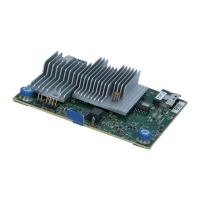Backed-out writesBacked-out writes
After parity initialization is complete, random writes to a RAID 5, 50, 6, or 60 can use a faster backed-out write operation. A backed-out write uses the existing
parity to calculate the new parity data. As a result, the write penalty for RAID 5 and RAID 50 is always four drive operations, and the write penalty for a RAID 6
and RAID 60 is always six drive operations. As you can see, the write penalty is not influenced by the number of drives in the array.
Backed-out writes is also known as "read-modify-write."
This method has the benefit of faster RAID, 5, 50, 6, or 60 random writes.
Full-stripe writesFull-stripe writes
When writes to the logical drive are sequential or when multiple random writes that accumulate in the flash-backed write cache are found to be sequential, a full-
stripe write operation can be performed. A full-stripe write allows the controller to calculate new parity using new data being written to the drives. There is almost
no write penalty because the controller does not need to read old data from the drives to calculate the new parity. As the size of the array grows larger, the write
penalty is reduced by the ratio of p / n where p is the number of parity drives and n is the total number of drives in the array.
This method has the benefit of faster RAID 5, 6, or 60 sequential writes.
Spare drivesSpare drives
SubtopicsSubtopics
Dedicated spareDedicated spare
Global spareGlobal spare
Dedicated spareDedicated spare
A dedicated spare is a spare drive that is dedicated to one array.
It supports any fault tolerant logical drive such as RAID 1, 10, 5, 6, 50, 60.
The dedicated spare drive activates anytime a drive within the array fails.
Global spareGlobal spare
A global spare drive replaces a failed drive in any array, as long as:
The drive type is the same.
The capacity of the global spare drives is equal to or larger than the capacity of the failed drive.
A global spare drive activates anytime a drive fails within a fault tolerant logical drive. For RAID 0 logical drives, the global spare is active when a member drive
reports a predictive failure.
Drive rebuildDrive rebuild
If a drive, which is configured as RAID 1, 5, 6, 10, 50, or 60 fails, the firmware automatically rebuilds the data on a spare or replacement drive to prevent data loss.
The rebuild is a fully automatic process. Monitor the progress of drive rebuilds in the Background Processes in Progress window.
Access the drive rebuild rate by selecting Set Adjustable Task Rate under the More Actions menu then locating it under the Priority Percentage column. Enter a
number from 1 to 100. The higher the number, the faster the rebuild will occur (and the system I/O rate might be slower as a result).
Foreign configuration importForeign configuration import
A foreign configuration import is a RAID configuration that exists on a replacement set of drives that you install in a computer system. You can use the HPE MR
Storage Administrator to import the foreign configuration to the controller or clear the foreign configuration so that you can create a configuration using these
drives.

